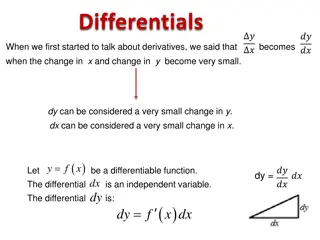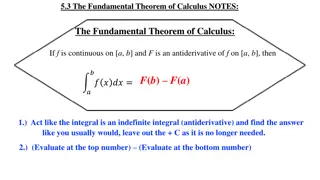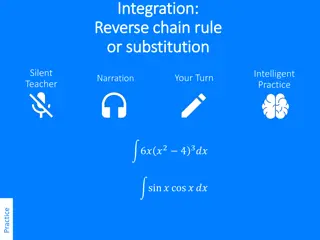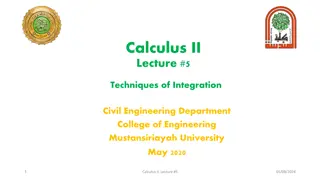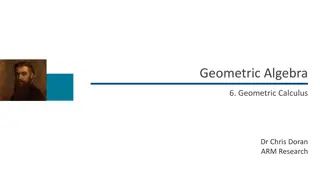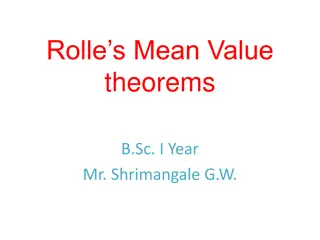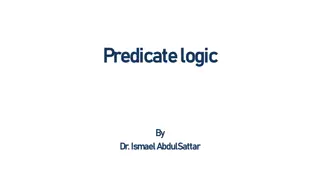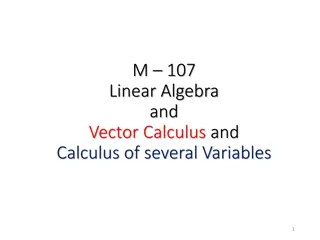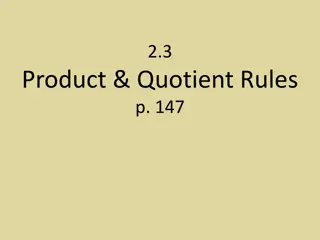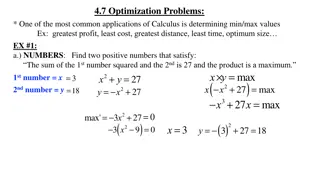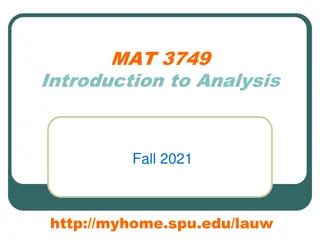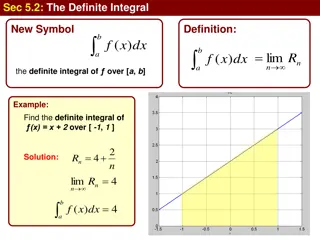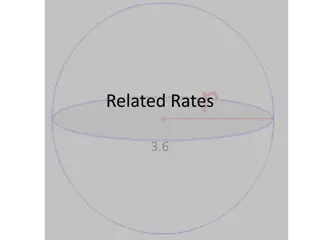Calculus Examples and Practice
Explore various calculus problems involving finding gradients, equations of tangents and normals, and analyzing curves. Practice determining gradients at specific points, solving for coordinates, and differentiating equations to find tangent and normal lines. Understand the relationship between gradients and points on graphs, and learn to determine equations of tangents and normals for curves. Improve your calculus skills with these helpful examples and exercises.
Download Presentation

Please find below an Image/Link to download the presentation.
The content on the website is provided AS IS for your information and personal use only. It may not be sold, licensed, or shared on other websites without obtaining consent from the author. Download presentation by click this link. If you encounter any issues during the download, it is possible that the publisher has removed the file from their server.
E N D
Presentation Transcript
Your Turn Find the gradient of the curve y = 3x4 at the point ( 2, 48). dy dx 3 =12 x Differentiating: At the point ( 2, 48) x = 2 so: dy dx 3 =12( 2) =12 8 = 96 The gradient of the curve y = 3x4 at the point ( 2, 48) is 96.
Equation of a Tangent or Normal Find the gradient of a curve at a point. Find the gradient of the tangent to a curve at a point. Find the equation of the tangent to a curve. Find the equation of the normal to a curve.
Using the result of differentiation Let ? ? = 4?2 8? + 3 Find the gradient of ? = ? ? at the point b) Find the coordinates of the point on the graph of ? = ? ? where the gradient is 8. c) Find the gradient of ? = ? ? at the points where the curve meets the line ? = 4? 5. 1 2,0 a) ? ? = 8? 8 When ? a Remember that the gradient function allows you to find the gradient for a particular value of ?. = 8 ? 1 2 1 2 8 = 4 b 8 = 8? 8 ? = 2 ? = 4 22 8 2 + 3 = 3 Point is 2,3 This example is important! Previously you used a value of ? to get the gradient ? ? . This time we re doing the opposite: using a known gradient ? ? to get the value of ?. We therefore substitute ? ? for 8. ? Once you have your ?, you need to work out ?. Ensure you use the correct equation! First find point of intersection: 4?2 8? + 3 = 4? 5 Solving, we obtain: ? = 1 or ? = 2 When ? = 1,? 1 = 0 When ? = 2,? 2 = 8 c ?
Your Turn Let ? ? = ?2 4? + 2 a) Find the gradient of ? = ? ? at the point 1, 1 b) Find the coordinates of the point on the graph of ? = ? ? where the gradient is 5. c) Find the gradient of ? = ? ? at the points where the curve meets the line ? = 2 ?. ? ? = 2? 4 When ? 1 = 2 1 4 = 2 ? a 5 = 2? 4 ? =9 2 b 2 ? 9 2 9 2 + 2 =17 ? = 4 4 9 2,17 Point is 4 ?2 4? + 2 = 2 ? Solving: ? = 0 or ? = 3 When ? = 0,? 0 = 4 When ? = 3,? 3 = 2 c ?
Finding the equation of a tangent Find the equation of the tangent to the curve ? = ?2 when ? = 3. We can use ? ?1= ? ? ?1 for the tangent (as it is a straight line!). Therefore we need: (a) A point ?1,?1 (b) The gradient ?. Gradient function: ?? ??= ?? ? ? Gradient when ? = 3: ? = ? ? ?-value when ? = 3: ? = ? So equation of tangent: ? ? = ? ? ? (3,?) ?
Finding the equation of the normal Find the equation of the normal to the curve ? = ?2 when ? = 3. Gradient function: ?? Gradient when ? = 3: ? = ? ?-value when ? = 3: ? = ? ??= ?? The normal to a curve is the line perpendicular to the tangent. Equation of tangent (from earlier): ? ? = ?(? ?) Therefore equation of normal: ? ? = ? ?? ? ? (3,9) Exam Tip: A very common error is for students to accidentally forget whether the question is asking for the tangent or for the normal.
Your Turn Find the equation of the normal to the curve ? = ? + 3 ? when ? = 9. ? y When ? = 9, ? = 9 + 3 9 = 18 1 2 ? = ? + 3? ?? ??= 1 +3 ??= 2 ??= 1 +3 ? gradient 2? 1 9 1 2 2 =3 Tip: I like to use ?? and ?? to make clear to the examiner (and myself) what gradient I ve found. 2 2 3 Equation of normal: ? 18 = 2 ? Final equation 3? 9
Your Turn ? ? ? ? ? ? ? ? ?





